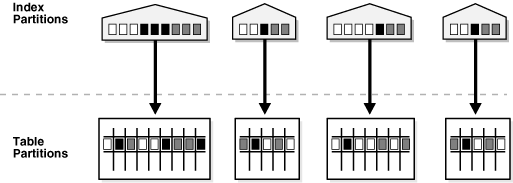Local Partitioned Indexes
Local partitioned indexes are easier to manage than other types of partitioned indexes. They also offer greater availability and are common in DSS environments. The reason for this is equipartitioning: each partition of a local index is associated with exactly one partition of the table. This functionality enables Oracle to automatically keep the index partitions synchronized with the table partitions, and makes each table-index pair independent. Any actions that make one partition's data invalid or unavailable only affect a single partition.
Local partitioned indexes support more availability when there are partition or subpartition maintenance operations on the table. A type of index called a local nonprefixed index is very useful for historical databases. In this type of index, the partitioning is not on the left prefix of the index columns. For more information about prefixed indexes, refer to "Index Partitioning".
You cannot explicitly add a partition to a local index. Instead, new partitions are added to local indexes only when you add a partition to the underlying table. Likewise, you cannot explicitly drop a partition from a local index. Instead, local index partitions are dropped only when you drop a partition from the underlying table.
A local index can be unique. However, in order for a local index to be unique, the partitioning key of the table must be part of the index's key columns.
Figure 2-6 offers a graphical view of local partitioned indexes.
For more information about local partitioned indexes, refer to "Local Partitioned Indexes".
